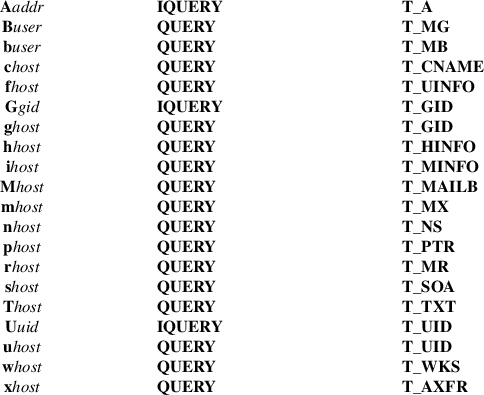NAME
nstest − DNS test shell
SYNOPSIS
nstest [-d] [-i] [-r] [-v] [-p port] [ inet_addr [logfile]]
DESCRIPTION
nstest is an interactive DNS test program. Queries are formed and sent by user command; any reply received is printed on the standard output. inet_addr is the Internet address of the DNS resolver to which nstest should send its queries. If inet_addr is not included, nstest first tries to contact a DNS server on the local host; if that fails, it tries the servers listed in the /etc/resolv.conf file. If a logfile is supplied, nstest uses it to log the queries sent and replies received.
OPTIONS
|
-d |
Causes nstest to create a file named ns_packet.dump (if it does not exist) and write into it a raw (binary) copy of each packet sent. If ns_packet.dump does exist, nstest will truncate it. | ||
|
-i |
Sets the RES_IGNTC flag on the queries it makes. See resolver(3RESOLV) for a description of the RES_IGNTC flag. | ||
|
-r |
Turns off the RES_RECURSE flag on the queries it makes. See resolver(3RESOLV) for a description of the RES_RECURSE flag. | ||
|
-v |
Turns on the RES_USEVC and RES_STAYOPEN flags on the res_send () calls made. See resolver(3RESOLV) for a description of the RES_USEVC and RES_STAYOPEN flags. | ||
|
-p |
Causes nstest to use the supplied port instead of the default name server port. |
USAGE
When nstest starts, it prints a prompt (">") and waits for user input. DNS queries are formed by typing a key letter followed by the appropriate argument. Each key letter results in a call to res_mkquery () with op set to either IQUERY or QUERY and type set to one of the type values (defined in <arpa/nameser.h>). (Any other key letter than those listed below causes nstest to print a summary of the following table.)

After the query is successfully formed, res_send () is called to send it and wait for a reply. nstest then prints the following on the standard output:
|
• |
a summary of the request and reply packets, including the HEADER structure (defined in <arpa/nameser.h>) used in the request | ||
|
• |
the question being asked of the name server | ||
|
• |
an enumeration of the name server(s) being polled | ||
|
• |
a summary of the HEADER structure received in the reply | ||
|
• |
the question the name server answered | ||
|
• |
the answer itself |
EXAMPLES
Example 1: Fetching the address of host playground.sun.com from the Sun name server.
To fetch the address of host playground.sun.com from the Sun name server, the user would enter:
$ nstest
192.9.5.1
> aplayground.sun.com
The utility nstest would return the following:
res_mkquery(0,
playground.sun.com, 1, 1)
res_send()
HEADER:
opcode = QUERY, id = 1, rcode = NOERROR
header flags: rd
qdcount = 1, ancount = 0, nscount = 0, arcount = 0
QUESTIONS:
playground.sun.com, type = A, class = IN
Querying server
(# 1) address = 192.9.5.1
got answer:
HEADER:
opcode = QUERY, id = 1, rcode = NOERROR
header flags: qr aa rd ra
qdcount = 1, ancount = 1, nscount = 0, arcount = 0
QUESTIONS:
playground.sun.com, type = A, class = IN
ANSWERS:
playground.sun.com
type = A, class = IN, ttl = 1 day, dlen = 4
internet address = 192.9.5.5
Example 2: Looking up a PTR record.
To look up a PTR record, enter:
$ nstest
192.9.5.1
> p5.5.9.192.in-addr.arpa
The utility nstest would return the following:
res_mkquery(0,
5.5.9.192.in-addr.arpa, 1, 12)
res_send()
HEADER:
opcode = QUERY, id = 2, rcode = NOERROR
header flags: rd
qdcount = 1, ancount = 0, nscount = 0, arcount = 0
QUESTIONS:
5.5.9.192.in-addr.arpa, type = PTR, class = IN
Querying server
(# 1) address = 192.9.5.1
got answer:
HEADER:
opcode = QUERY, id = 2, rcode = NOERROR
header flags: qr aa rd ra
qdcount = 1, ancount = 1, nscount = 0, arcount = 0
QUESTIONS:
5.5.9.192.in-addr.arpa, type = PTR, class = IN
ANSWERS:
5.5.9.192.in-addr.arpa
type = PTR, class = IN, ttl = 7 hours 47 mins 2 secs, dlen =
23
domain name = playground.sun.com
FILES
/usr/include/arpa/nameser.h
include file for implementation of DNS protocol
/usr/include/resolv.h
include file for the resolver daemon (in.named)
ATTRIBUTES
See attributes(5) for descriptions of the following attributes:
